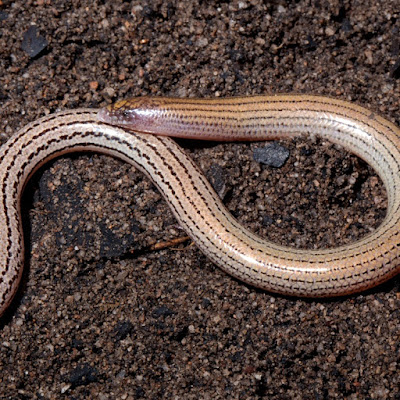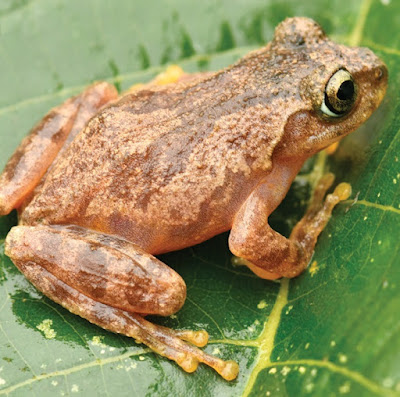[Most Recent Entries] [Calendar View]
Tuesday, June 4th, 2019
| Time | Event | ||
| 3:01a | [Herpetology • 2019] Lerista anyara • A New Species of Lerista Bell, 1833 (Reptilia: Scincidae) from Cape York Peninsula, Queensland, belonging to the Lerista allanae Clade but strongly Disjunct from other Members of the Clade
Abstract A species of the skink genus Lerista is described from Cape York Peninsula in Queensland. The species is biogeographically interesting as it appears to be separated by at least 500 km from its nearest relatives, members of the Lerista allanae clade. The role of Pleistocene sea level changes altering availability of suitable habitat for these sand specialists is discussed as a possible driver of isolation and speciation. Keywords: Reptilia, Slider skink, Cape York Peninsula, Australia, Olkola country, monsoonal tropical savanna Andrew P. Amey, Patrick J. Couper and Jessica Worthington Wilmer. 2019. A New Species of Lerista Bell, 1833 (Reptilia: Scincidae) from Cape York Peninsula, Queensland, belonging to the Lerista allanae Clade but strongly Disjunct from other Members of the Clade. Zootaxa. 4613(1); 161–171. DOI 10.11646/zootaxa.4613.1.9 | ||
| 3:26a | [Herpetology • 2019] Gracixalus yunnanensis • A New Species of Gracixalus (Anura, Rhacophoridae) from Yunnan, China
Abstract A new species of the genus Gracixalus, Gracixalus yunnanensis sp. n., is described based on a series of specimens collected from southwestern and southern Yunnan, China. This species is distinguished from all other known congeners by a combination of the following characters: relatively small body size in adult males (SVL 26.0–34.2 mm); dorsal surface yellow brown or red brown; distinctive conical asperities on dorsum; males with an external subgular vocal sac and linea masculina; throat, chest, and belly nearly immaculate; venter surface orangish with yellow spots, semi-transparent; snout rounded; supratympanic fold distinct; iris bronze; lack of white patch on temporal region; tibiotarsal projection absent; sides of body nearly smooth with no black blotch; finger webbing rudimentary; and toe webbing formula I1.5–2II1.5–2.7III.5–3IV2.5–1.5V. Genetically, the new species diverges from its congeners by 2.2%–14.1% (uncorrected p-distance) and is closest to G. guangdongensis. However, the new species can morphologically be separated from G. guangdongensis by distinctive conical tubercles on dorsum (versus absent), lateral surface nearly smooth with no black blotches on ventrolateral region (versus lateral surface rough, scattered with tubercles and black blotches on ventrolateral region), snout rounded (versus triangularly pointed), iris bronze (versus iris brown), and ventral surface orangish (versus throat and chest creamy white and belly light brown). Keywords: Gracixalus yunnanensis sp. n., taxonomy, Rhacophoridae, southwestern China Gracixalus yunnanensis sp. n. Diagnosis: The new species is assigned to genus Gracixalus based upon molecular data and the following morphological characters: the presence of intercalary cartilage between terminal and penultimate phalanges of digits, tips of digits enlarged to discs bearing circummarginal grooves, vomerine teeth absent, inner (first and second) and outer (third and fourth) fingers non-opposable, and an inversed Y-shaped dark brown marking on dorsum (Fei 1999, Rowley et al. 2011, Chen et al. 2018). The new species is distinguished from its congeners by a combination of 1) SVL 26.0–34.2 mm in males; 2) dorsal surface yellow brown or red brown; 3) distinctive conical tubercles on dorsum; 4) males with an external subgular vocal sac; 5) throat granular; 6) finger webbing rudimentary; 7) linea masculina, a band of connective tissue between the rectus abdominus muscle and oblique abdominus muscle, present in males; 8) tibiotarsal articulation reaching eye; 9) snout rounded; 10) white patch absent on temporal region; 11) tibiotarsal projection absent; 12) supratympanic fold distinct; 13) ventral surface orangish, nearly immaculate, and semi-transparent; 14) nuptial pads present on finger I; 15) heels overlapping when legs at right angle to body; 16) iris bronze; and 17) body sides nearly smooth with no black blotch. Distribution: In China, the new species is known from Yunnan (Lancang County, Menghai County, Lvchun County, and Jinping County). In addition, the new species also occurs in Laos (Houapan) and Vietnam (Lao Cai and Nghe An) because our molecular analyses revealed that samples from Houapan (KUHE 32453), Lao Cai (VNMN 4355, 4357, 4371), and Nghe An (AMS R173454) that were sequenced by previous studies also belong to the new species (Figs 2, 3). In Yunnan, specimens were found sitting on leaves of herbaceous plants (e.g., Amomum tsaoko and Eupatorium adenophorum). No eggs and tadpoles were found. Etymology: The specific epithet yunnanensis refers to the distribution of this species in China, Yunnan Province. Guohua Yu, Hong Hui, Jian Wang, Dingqi Rao, Zhengjun Wu and Junxing Yang. 2019. A New Species of Gracixalus (Anura, Rhacophoridae) from Yunnan, China. ZooKeys. 851: 91-111. DOI: 10.3897/zookeys.851.32157 | ||
| 3:49a | [Botany • 2019] Gymnosiphon queenslandicus (Burmanniaceae) • A New Addition to the Mycoheterotroph Flora of Tropical Rainforest in Australia
Abstract The mycoheterotrophic genus Gymnosiphon Blume is recorded for Australia for the first time after the recent discovery of plants at Mossman Gorge, Queensland. On the basis of examination of living plants in the field as well as materials preserved in spirit, the Mossman Gorge Gymnosiphon taxon is a novelty closely related to Gymnosiphon affinis J.J.Sm., which is known only from New Guinea. The new species is here described as Gymnosiphon queenslandicus B.Gray & Y.W.Low based on floral characteristics important for species distinction in the genus. Keywords: Dioscoreales, endemic, monocots, Queensland. Bruce Gray, Ridha Mahyuni and Yee Wen Low. 2019. Gymnosiphon queenslandicus (Burmanniaceae), A New Addition to the Mycoheterotroph Flora of Tropical Rainforest in Australia. Australian Systematic Botany. 32(3) 139-145. DOI: 10.1071/SB18035 | ||
| 7:27a | [Herpetology • 2019] Cnemaspis godagedarai • A New Species of Endemic Day Gecko (Reptilia: Gekkonidae: Cnemaspis) from A Wet Zone Forest in the Second Peneplain of Southern Sri Lanka
Abstract A new day gecko species of the genus Cnemaspis Strauch, 1887 is described from a geographically separated forested area in Ensalwatte, Matara district, Sri Lanka. This species is medium (34–35mm SVL) in size and can be differentiated from all other Sri Lankan congeners by a suite of distinct morphometric, meristic, and color characters. The species is recorded from rock outcrop habitats in wet, cool, and shady forest with minimal anthropogenic disturbance at low-elevations (below 860 m). Existing data suggest this gecko is a point endemic. Being a rupicolous microhabitat specialist with a scansorial mode of life, this species is susceptible to both localized and widespread threats. Therefore, isolated forest patches warrant special conservation action, including habitat protection, in-depth research, and species-specific hands-on management practices. Keywords. Conservation, critically endangered, microhabitat, natural history, point endemic, redlist, Sri Lankan warrior, threats Cnemaspis godagedarai sp. nov. Godagedaras’ Day Gecko (English) Godagedarage Diva-seri Hoona (Sinhala) Godagedaravin Pahalpalli (Tamil) Diagnosis: Cnemaspis godagedarai sp. nov., can be readily distinguished from its Sri Lankan congeners by the following combination of morphological and meristic characteristics and color pattern: maximum SVL 35.5 mm; dorsum with homogeneous, smooth, granular scales; 2/2 supranasals; one internasal and 1/1 postnasal present; 26– 28 interorbital scales present; 14–15 supraciliaries, 11–12 canthal scales, 24–26 eye to tympanum scales; three enlarged postmentals; postmentals bounded by 5–6 chin scales; chin and gular scales smooth, juxtaposed granules; pectoral and abdominal scales smooth, subimbricate; 21– 23 belly scales across venter; 5–6 weakly developed tubercles on posterior fank; 101–106 paravertebral granules linearly arranged; precloacal pores absant in males, 12–13 femoral pores in males and 8–9 unpored interfemoral scales in males; 133–137 ventral scales; 98–102 midbody scales; subcaudals smooth, large subhexagonal, subequal in width, in a regular series forming a median row; 7–8 supralabials; 7–8 infralabials; 17–18 subdigital lamellae on digit IV of manus, and 20–21 subdigital lamellae on digit IV of pes. .... Etymology: The specific epithet is an eponym Latinized (godagedarai) in the masculine genitive singular, honoring Sri Lankan warrior Godagedara Rate Adhikaram for his valiant feats in the Great Rebellion of 1817–1818, which was initiated in Uva-Wellassa. Habitat and ecology: The Ensalwatte forest area is a Mesua-Doona-dominated tropical evergreen rainforest ~150 ha in size (Gunatileke and Gunatileke 1990), located in the lowland wet zone of southern Sri Lanka (near Deniyaya, Mathara District, Southern Province). The area ... with an elevation range of 620–860 m (Fig. 4). The mean annual rainfall is 2,500–3,500 mm, received mostly during the southwest monsoon (May-September) season. The mean annual temperature is 22–25 ºC. Only six specimens (four females and two males) were found on scattered boulders. The new species was sympatric (at both local habitat and microsite scales) with several other micro-endemic geckos (Cnemaspis pulchra and Cyrtodactylus subsolanus). No eggs were found in the same habitat. These microhabitats were well-shaded (light intensity 0–587 Lux), relatively moist (relative humidity 73–88%) and cool (rock-surface temperature 25.3–27.5 °C). Remarks: Of its insular congeners, Cnemaspis godagedarai sp. nov. most closely resembles C. gemunu, C. phillipsi, and C. scalpensis. The type localities of these species are separated by ~60 km (Hakgala in Central highland), ~95 km (Kandy in Central highland), and ~100 km (Gammaduwa in Knuckles highland) airline distances, respectively, from Ensalwatte in Deniyaya (Fig. 1). Anslem de Silva, Aaron M. Bauer, Madhava Botejue and Suranjan Karunarathna. 2019. A New Species of Endemic Day Gecko (Reptilia: Gekkonidae: Cnemaspis) from A Wet Zone Forest in the Second Peneplain of Southern Sri Lanka. Amphibian & Reptile Conservation 13(1) [General Section]: 198–208 (e177). |
| << Previous Day |
2019/06/04 [Calendar] |
Next Day >> |















